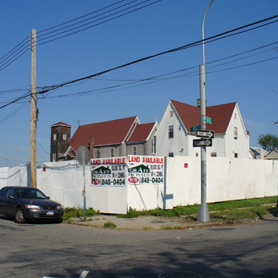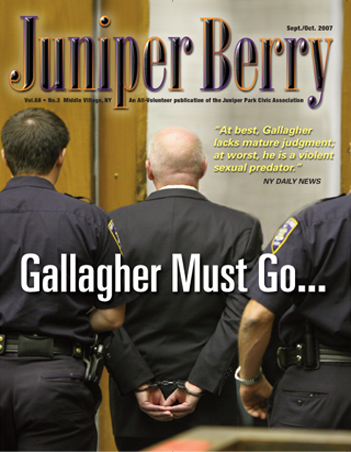This past summer, the Juniper Park Civic Association rallied civic members, preservationists and neighbors of the St. Saviour’s property together to call on the city to help them save the church and green grounds for future generations. Although less than a month later, the trees on the property had spitefully been cut down by the developer, the JPCA vows to continue to fight to save this important piece of Maspeth’s – and New York’s – history.
First, we’ll revisit our July 1st rally:
It was a beautiful summer day during a holiday weekend, but that didn't stop more than 80 concerned residents of New York City, some coming from as far west as Manhattan and as far east as Bayside, from attending our rally, co-sponsored by Councilman Tony Avella.
The civic association has been battling developers and city hall since early 2006 to save the church, designed in 1847 by Richard Upjohn, and founded by early settlers in Maspeth, including Congressman James Maurice, author Garrit Furman, farmer John Van Cott and judge David S. Jones. Originally founded as an Episcopal Church, it was sold to a Korean Methodist congregation in 1997. That group sold the land to Maspeth Development, LLC in 2005. The developer has expressed interest in building 70+ units of housing on the site.
“Our councilman, Dennis Gallagher, was down here in December when workers were found violating a stop work order,” said JPCA President Robert Holden. “He phoned the developer to ask him why he had workers down here, and he called him 'Tommy.' So we have a councilman who didn't send a representative to any of our rallies and who knows the developer on a first name basis. This makes you wonder whether Councilman Gallagher is representing the interests of his constituents or the developer,” Holden said.
Councilman Tony Avella, who has attended all of the St. Saviour's rallies, recounted his year-old threat to the developer. “I told him, 'If you tear this church down, forget about coming to me for a zoning change',” Avella, who is Chair of the City Council's Zoning Subcommittee warned.
Councilman Avella also said it was incredible that the JPCA has been fighting to save the property for this long. “It's ridiculous that after more than a year-and-a-half, you are still fighting to save this property. The city is not doing it's job.”
Christabel Gough, Secretary of the Society for the Architecture of the City, based in Manhattan, said, “This is one of the most historic places in New York. It's shameful that the Landmarks Commission has backed away from you, I think it's a political decision and we're fighting it, but so far we have had to look to Juniper Civic to keep this place standing. So thank you all for what you've done and keep after it, because we will win, I believe.” Gough donated the money to fund the lawsuit brought by the JPCA last year against the developer, based on the 1878 deed in which James Maurice donated land for a churchyard and said it must always be used for church purposes. The suit was dismissed by a judge last summer, who said that the restrictive covenant had been extinguished.
Robert Holden said, “The church was founded by Maspeth pioneers and artifacts connected to the American Revolution, which was fought in the area, have been found on the land.” Holden also spoke of the environmental impact the trees had. “I counted 185 trees on this property. This area has the worst air quality in the entire state. We can't afford to lose this green space,” he said.
“We have a mayor who says he wants to green New York,” said Tony Nunziato, Chair of the Maspeth-Middle Village Task Force. “So why does he want to take an entire block of green and turn it gray? If he really wants to have a green environment, then St. Saviour's has to be saved.”
“I come down here often, and what I see are kids playing in a parking lot and on the railroad tracks,” said Christina Wilkinson, Chair of JPCA's Committee to Save St. Saviour's. “The Parks Department tells people who live in this area that their closest park is Principe Park. Kids are forced to walk down a truck route, past an adult establishment and through an industrial area to get to that park, which is more than 10 minutes walking distance from here. This doesn't make any sense when there is a beautiful green space just crying out to be made into a park, community center and museum right across the street from where they live.”
Wilkinson read a letter from Rego-Forest Preservation Council Chair, Michael Perlman, who could not attend the rally. He had this to say to Mayor Bloomberg:
“This is judgment day, so think twice about ridiculing & discarding 160 years of our architectural, cultural, & archaeological history, and our environmental attributes, into a landfill. Is this the ideal of progress? Leave something for this generation to cherish, pay tribute to our ancestors, and inform, inspire, and set an example for our children to come. Be a savior of St. Saviour's!”
Jim Driscoll, President of the Queens Historical Society, explained that Maspeth is steeped in history and that former mayor and governor Dewitt Clinton had planned the Erie Canal from his summer house alongside Newtown Creek. The house burned down in 1933 and the creek is now the most polluted body of water in the country.
After the initial gathering, the attendees formed a procession and circled once around the property, holding signs and chanting “Save St. Saviour's” and “What do we want? A park! When do we want it? Now!”
Sumeet Sharma, representing State Senator Serphin Maltese, said at the conclusion of the event, “Senator Maltese supports saving St. Saviour's, and hopefully we can all team up and get this church saved, especially since it's such an important site in Queens. Save St. Saviour's!”
During the week of July 9th, things took a turn for the worse when the developer had workers cut down most of the trees that had been on the property to spite us for calling for the site to be converted into a park. This temporarily dampened our spirits; however, an emergency protest rally was quickly called by JPCA and Councilman Avella for Saturday July 14th to denounce the action and those responsible.
When we arrived at the site, the devastation of the land was hard to stomach. It looked like a battle scene.
Councilman Avella expressed outrage over what the developer had done. He vowed as chair of the city council's zoning committee to completely reject the developer's application for a zoning change from manufacturing to residential in order to build 70+ housing units on the property. He said that Councilman Gallagher had been informed of the developer’s plan to cut the trees and did nothing to try to stop it.
Neighbors who attended the rally expressed understandable shock, sadness and anger at Councilman Gallagher's role in the cutting and Mayor Bloomberg's refusal to save the trees while he continues to boast about how he plans to “green” the city.
The anger turned into hope and positive energy as speaker after speaker vowed to continue to keep fighting to save this open space and convert it into a park for the community.
At the conclusion of the press conference, attendees gathered at the site of a tree trunk that was placed in the street to reserve parking for the arboreal crew.
After the crowd dispersed, members of the JPCA took a cross-cut of the trunk so that the rings could be counted. (Based on the number of rings, the tree had later been estimated to have been 160 years old, meaning it was planted around the time of the opening of the church, probably as part of a planned landscape.)
Shortly after we left the scene, we were called back by residents frantic over the reappearance of a tree cutting service.
Workers were observed on the eastern end of the property cutting down the trees there, allowing limbs to rain down onto the sidewalk and damaging cars parked in the street. Nests of birds and squirrels were clearly visible in the trees that were targeted. A truck containing a cherry picker was obstructing traffic flow. It was noted that the truck had its DOT # scratched off of it.
Residents stood under the cherry picker, forcing the operator to lower it to the ground. A verbal confrontation then took place between JPCA members and the tree-cutting crew.
The police were called to the scene and issued a slew of summonses to the company and forced them to vacate. The sanitation department also responded and issued a $300 ticket to the property owner for the tree trunks on the sidewalk & street.
The workers left, taking more than a century and a half of Maspeth's natural history with them. They came back on July 24th and finished cutting down the remainder of the trees, and now St. Saviour’s stands alone, atop Maspeth Hill. The formerly green space now looks like a disaster area. A “for rent” sign hangs on the fence, and the developer is asking for $20,000 per month to rent out the entire space. It’s a ridiculous price and likely just a tactic being used to show the zoning committee or the Board of Standards and Appeals that the developer tried to use the property for a purpose within the zoning regulations but couldn’t make a return on his investment by doing so. As far as we’re concerned, a zoning change was never a guarantee, and the developer should have known the risk he was taking before he purchased the property.
The Juniper Park Civic Association continues to fight to save this important historical and architectural gem as well as the open space around it. We are meeting with members of the Bloomberg administration and elected officials to discuss options for obtaining the property through means other than the million dollars that Dennis Gallagher claimed he had gotten allocated in the city budget to purchase the property. If this money truly existed, then the church would have been purchased already, at least some of the trees would still be standing, and neighbors would not be concerned about the possibility of an “accidental” fire taking place.
As for the arboricide – while the loss of the original sycamore and oak trees is deplorable, new trees will grow back. Tony Nunziato, Maspeth’s own “Enchanted Florist,” suggested that after the land is saved, trees could be planted in memory of those who came before us to make Maspeth great. “A tree would be a living monument dedicated to their memories that would be appreciated by and benefit current and future generations,” he said.



